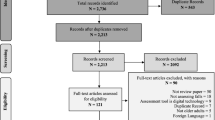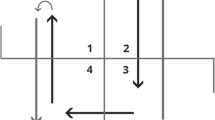Summary
The Tinetti test has been recommended and widely used in the elderly to assess mobility, balance and gait, and predict falls. Different versions can be found. A systematic literature search identified 37 publications on the Tinetti test and falls. Wide variations were found concerning name of the instrument, test items, scoring, and cut-off values. This heterogeneity interferes with evaluations of the test’s validity, reliability and generalisability. Researcher and clinicians should be aware of this fact, when dealing with the Tinetti test.
Zusammenfassung
Der Tinetti-Test ist ein empfohlenes und weit verbreitetes Instrument zum Assessment von Mobilität, Balance und Gang sowie zur Sturzvorhersage. Verschiedene Versionen des Instruments liegen vor. Eine systematische Literatursuche identifizierte 37 Publikationen zum Tinetti-Test im Zusammenhang mit Stürzen. Große Variationen fanden sich in Bezug auf Name des Instruments, Items, Scoring und Schwellenwert. Diese Heterogenität erschwert die Evaluation von Validität, Reliabilität und Generalisierbarkeit des Instruments. Wissenschaftler und Kliniker, die dieses Instrument einsetzen, sollten sich dieser Problematik bewusst sein.
Similar content being viewed by others
Literatur
Baloh RW, Spain S, Socotch TM, Jacobson KM, Bell T (2005) Posturography and balance problems in older people. J Am Geriatr Soc 43:638– 644
Bloem BR, Grimbergen YA, Cramer M, Willemsen M, Zwinderman AH (2001) Prospective assessment of falls in Parkinson’s disease. J Neurol 248:950–958
Bright L (2005) Strategies to improve the patient safety outcome indicator: preventing or reducing falls. Home Healthc Nurse 23:29–36
Bruyere O, Wuidart MA, Di Palma E, Gourlay M, Ethgen O, Richy F, Reginster JY (2005) Controlled whole body vibration to decrease fall risk and improve health-related quality of life of nursing home residents. Arch Phys Med Rehabil 86:303–307
Chiu AY, Au-Yeung SS, Lo SK (2003) A comparison of four functional tests in discriminating fallers from nonfallers in older people. Disabil Rehabil 25:45–50
Cho BL, Scarpace D, Alexander NB (2004) Tests of stepping as indicators of mobility, balance, and fall risk in balance-impaired older adults. J Am Geriatr Soc 52:1168–1173
Chu LW, Chi I, Chiu AY (2005) Incidence and predictors of falls in the Chinese elderly. Ann Acad Med Singapore 34:60–72
Cipriany-Dacko LM, Innerst D, Johannsen J, Rude V (1997) Interrater reliability of the Tinetti balance scores in novice and experienced physical therapy clinicians. Arch Phys Med Rehabil 78:1160–1164
Conner-Kerr T, Templeton MS (2002) Chronic fall risk among aged individuals with type 2 diabetes. Ostomy Wound Manage 48:28–35
Deutsche Gesellschaft für Allgemeinmedizin und Familienmedizin (2004) DEGAM-Leitlinie Ältere Sturzpatienten. http://www.degam.de/leitlinien/ sturz_web.pdf: Accessed 16/5/06
Di Fabio RP, Seay R (1997) Use of the “fast evaluation of mobility, balance, and fear” in elderly community dwellers: validity and reliability. Phys Ther 77:904–917
Dyer CA, Taylor GJ, Reed M, Dyer CA, Robertson DR, Harrington R (2004) Falls prevention in residential care homes: a randomised controlled trial. Age Ageing 33:596–602
Galindo-Ciocon DJ, Ciocon JO, Galindo DJ (1995) Gait training and falls in the elderly. J Gerontol Nurs 21:10–17
Hale WA, Delaney MJ, McGaghie WC (1992) Characteristics and predictors of falls in elderly patients. J Fam Pract 34:577–581
Harada N, Chiu V, Damron-Rodriguez J, Fowler E, Siu A, Reuben DB (1995) Screening for balance and mobility impairment in elderly individuals living in residential care facilities. Phys Ther 75:462–469
Ishizuka MA, Mutarelli EG, Yamaguchi AM, Jacob Filho W (2005) Falls by elders with moderate levels of movement functionality. Clinics 60:41–46
Justice AC, Covinsky KE, Berlin JA (1999) Assessing the generalizability of prognostic information. Ann Intern Med 130:515–524
Kerber KA, Enrietto JA, Jacobson KM, Baloh RW (1998) Disequilibrium in older people: a prospective study. Neurology 51:574–580
Köpke S, Lange H, Meyer G (2004) Validität von Tests zur Einschätzung des Sturzrisikos älterer Menschen [Abstract]. Z Gerontol Geriatr 37:S14
Kompetenzzentrum Geriatrie (2006) INFO – Service/Accessmentinstrumente in der Geriatrie: http://www. kcgeriatrie.de/instrumente/tinetti. htm: Accessed 16/5/06
Lin MR, Hwang HF, Hu MH, Wu HD, Wang YW, Huang FC (2004) Psychometric comparisons of the timed up and go, one-leg stand, functional reach, and Tinetti balance measures in community-dwelling older people. J Am Geriatr Soc 52:1343–1348
McGinty S, Masters L, Till D (1999) Inter-tester reliability using the Tinetti gait and balance assessment scale. Issues on Aging 22:1–6
Meyer G (2003) Kritische Bewertung eines Screening-Instrumentes zur Vorhersage des Sturzrisikos älterer Menschen. Z Arztl Fortbild Qualitatssich 97:27–31
Mount J, Bolton M, Cesari M, Guzzardo K, Tarsi J Jr (2005) Group balance skills class for people with chronic stroke: a case series. J Neurol Phys Ther 29:24–33
Murphy M, Olson SL, Protas EJ, Overby A (2003) Screening for falls in community-dwelling elderly. J of Aging Phys Act 11:66–80
Perell KL, Nelson A, Goldman RL, Luther SL, Prieto-Lewis N, Rubenstein LZ (2001) Fall risk assessment measures: an analytic review. J Gerontol A Biol Sci Med Sci 56:M761–766
Quadri P, Tettamanti M, Bernasconi S, Trento F, Loew F (2005) Lower limb function as predictor of falls and loss of mobility with social repercussions one year after discharge among elderly inpatients. Aging Clin Exp Res 17:82–89
Raiche M, Hebert R, Prince F, Corriveau H (2000) Screening older adults at risk of falling with the Tinetti balance scale. Lancet 356:1001–1002
Robbins AS, Rubenstein LZ, Josephson KR, Schulman BL, Osterweil D, Fine G (1989) Predictors of falls among elderly people. Results of two population-based studies. Arch Intern Med 149:1628–1633
Rolland Y, Rival L, Pillard F, Lafont C, Rivere D, Albarede J, Vellas B (2000) Feasibily of regular physical exercise for patients with moderate to severe Alzheimer disease. J Nutr Health Aging 4:109–113
Shumway-Cook A, Gruber W, Baldwin M, Liao S (1997) The effect of multidimensional exercises on balance, mobility, and fall risk in community- dwelling older adults. Phys Ther 77:46–57
Speciale S, Turco R, Magnifico F, Bellelli G, Trabucchi M (2004) Frailty is the main predictor of falls in elderly patients undergoing rehabilitation training. Age Ageing 33:84–85
Thapa PB, Gideon P, Brockman KG, Fought RL, Ray WA (1996) Clinical and biomechanical measures of balance as fall predictors in ambulatory nursing home residents. J Gerontol A Biol Sci Med Sci 51:M239–246
Thomas JI, Lane JV (2005) A pilot study to explore the predictive validity of 4 measures of falls risk in frail elderly patients. Arch Phys Med Rehabil 86:1636–1640
Tinetti ME, Williams TF, Mayewski R (1986) Fall risk index for elderly patients based on number of chronic disabilities. Am J Med 80:429–434
Tinetti ME (1986) Performance-oriented assessment of mobility problems in elderly patients. J Am Geriatr Soc 34:119–126
Tinetti ME, Ginter SF (1988) Identifying mobility dysfunctions in elderly patients. Standard neuromuscular examination or direct assessment? JAMA 259:1190–1193
Tinetti ME, Speechley M, Ginter SF (1988) Risk factors for falls among elderly persons living in the community. N Engl J Med 319:1701–1707
Topper AK, Maki BE, Holliday PJ (1993) Are activity-based assessments of balance and gait in the elderly predictive of risk of falling and/or type of fall? J Am Geriatr Soc 41:479–487
Trueblood PR, Hodson-Chennault N, McCubbin A, Pacheco R, Youngclark D (2001) Performance and impairment- based balance assessments among community dwelling elderly: sensitivity and specificity. Issues on Aging 24:2–6
VanSwearingen JM, Brach JS (2001) Making geriatric assessment work: selecting useful measures. Phys Ther 81:1233–1252
Vassallo M, Stockdale R, Sharma JC, Briggs R, Allen S (2005) A comparative study of the use of four fall risk assessment tools on acute medical wards. J Am Geriatr Soc 53:1034–1038
Verghese J, Buschke H, Viola L, Katz M, Hall C, Kuslansky G, Lipton R (2002) Validity of divided attention tasks in predicting falls in older individuals: a preliminary study. J Am Geriatr Soc 50:1572–1576
Author information
Authors and Affiliations
Corresponding author
Rights and permissions
About this article
Cite this article
Köpke, S., Meyer, G. The Tinetti test. Z Gerontol Geriatr 39, 288–291 (2006). https://doi.org/10.1007/s00391-006-0398-y
Received:
Accepted:
Issue Date:
DOI: https://doi.org/10.1007/s00391-006-0398-y




